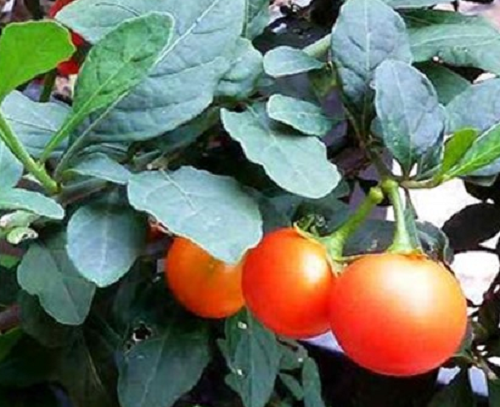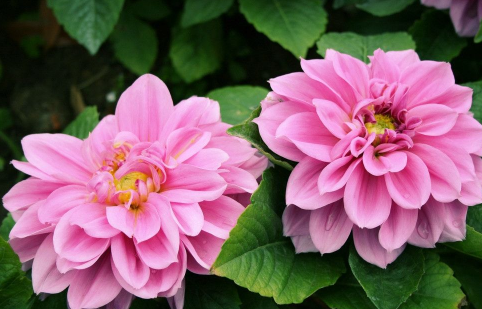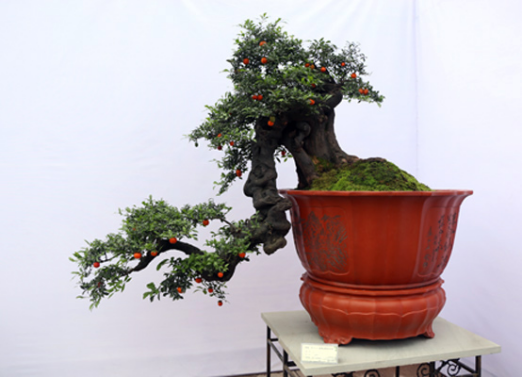Culture methods of winter coral
1. Flowerpots and soil.
Winter coral culture should choose flowerpots of the right size, loose, fertile and well-drained soil, and some humus fertilizer can be added as base fertilizer.
2. Light and temperature.
Winter coral likes a warm and sunny growing environment. It is suitable to grow at a temperature of between 18 and 25 degrees. When the temperature is low in winter, it is necessary to ensure that the indoor environment is not less than 5 degrees, so that it can survive the winter safely. Winter corals like sunlight, so they should be placed in places where they can be exposed to sunlight in winter, and in places where direct light can be avoided when the light is strong in summer.
3. Watering and fertilizing.
Winter corals are not resistant to drought, but they are also afraid of waterlogging, so they should pay attention to proper watering in the process of breeding to keep the basin soil moist. The period of fertilization is half a month, and thin liquid fertilizer is applied once every half month. Some phosphate fertilizer can be applied before flowering to help flowers multiply and bear more fruits. The amount of fertilizer should be controlled after flowering so as not to burn out the plant too much and cause the flowers and fruits to fall. When the fruit grows to the size of mung bean grain, you can apply water fertilizer and some phosphorus and potassium fertilizer to make the fruit bright and bright.

Culture methods and matters needing attention of winter coral
Latin name Solanum pseudocapsicum L. Var. Diflorum (Vell.) Bitter
Don't call it coral cherry or Jiqingguo.
The plant kingdom.
Phylum angiosperm
Dicotyledonous class
Subclass synpetalous flower
Order Tubularia
Family Solanaceae
Family eggplant tribe
Genus Solanum
The distribution area is native to Europe and subtropics, but it is wild in Yunnan, China.
Winter coral, now known as coral bean (Solanum pseudocapsicum L. Var. Diflorum (Vell.) Bitter). Erect shrubs, much branched into clusters, cultivated for 1-2 years. The plant height is 30ml / 60cm. Leaves alternate, narrowly oblong to oblanceolate. Summer and autumn flowering, flowers small, white, axillary. Berries, dark orange-red, globose, 1 Mel 1.5 cm in diameter. After flowering, the fruit will not fall for a long time, but it can be retained on the branches until after the Spring Festival. Now there are dwarf species cultivated, and the plant shape is short and multi-branched. Berries, seeds small, fruit shaped in a wide ellipsoid, apical tip. Aliases are: coral cherry, Jiqing fruit, coral son, coral beans, jade coral, red coral, wild spicy eggplant, wild sea pepper, look cherry, four seasons fruit.
1. Morphological characteristics.
Coral beans (Beijing) Jade Coral (Japan); Pomegranate (Yixian County, Shaanxi Province); Yanghai Pepper (Leibo, Sichuan); Winter Coral (Anjiang, Hunan). (variant)
Erect branched shrubs, 0.3-1.5 m tall, branchlets branched tomentose when young, then gradually deciduous. Leaves twin, unequal in size, elliptic-lanceolate, 2-5 cm long or slightly long, 1-1.5 cm wide or slightly wide, apex obtuse or mucronate, base cuneate-decurrent into short stalk, leaf surface glabrous, leaves often dendritic tomentose along veins below, margin entire or slightly undulate, midrib protruding below, lateral veins 4-7 on each side, obvious below Petiole ca. 2-5 mm, dendritic tomentose when young, then gradually deciduous. Inflorescences short, axillary, usually 1-3-flowered, solitary or into scorpion tails, total pedicels short to nearly absent, pedicels ca. 5 mm, flowers small, ca. 8-10 mm in diam. Calyx green, 5-parted, lobes ovate-lanceolate, tip obtuse, ca. 5 mm long, Corolla white, tube concealed in calyx, ca. 1.5 mm long, limb about 6.5-8.5 mm long, 5-parted, lobes ovoid, ca. 4-6 mm long, ca. 4 mm wide, tip tip or obtuse; filaments ca. 1 mm long, anthers oblong, about 2 times as long as filaments, apical hole slightly inward Ovary suborbicular, ca. 1.5 mm in diam., style ca. 4-6 mm, stigma truncate. Berries solitary, globose, coral red or orange, 1-2 cm in diam.; seeds flattened, ca. 3 mm in diam. The flowering period is from April to July and the fruit ripening stage is from August to December.
2. Related species
Coral cherry (original variety)
Var. Pseudo-capsicum
Erect branched shrubs, up to 2 m tall, smooth glabrous throughout. Leaves alternate, narrowly oblong to lanceolate, 1-6 cm long and 0.5-1.5 cm wide, apex pointed or obtuse, base narrowly cuneate extending into petiole, margin entire or undulate, both surfaces smooth glabrous, midvein protruding below, lateral veins 6-7 pairs, more obvious below; petiole ca. 2-5 mm, cannot be completely separated from leaf blade. Flowers solitary, rarely caudate, without peduncle or nearly without peduncle, extraaxillary or subopposite leaf, pedicel ca. 3-4 mm; flowers small, white, ca. 0.8-1 cm in diam.; calyx green, ca. 4 mm in diam., 5-lobed, lobes ca. 1.5 mm long; Corolla tube concealed in calyx, less than 1 mm long, limb ca. 5 mm long, lobes 5, ovate, ca. 3.5 mm long, ca. 2 mm wide Filaments less than 1 mm long, anthers yellow, rectangular orbicular, ca. 2 mm; ovary suborbicular, ca. 1 mm in diam., style short, ca. 2 mm, stigma truncate. Berries orange-red, 1-1.5 cm in diameter, calyx persistent, petiole ca. 1 cm long, tip dilated. Seeds discoid, flattened, ca. 2-3 mm in diam. Flowering in early summer and fruiting in late autumn.
3. Growth habits
Especially found in the field side, roadside, jungle or ditch edge, 1350-2800 meters above sea level is common, 600m area also has distribution.
Winter corals like sunshine, warmth and high temperature resistance, and there is no sunburn above 35 ℃. Not resistant to shade, cold, drought, hot summer afraid of rain, waterlogging. It is not strict with the soil, but it grows vigorously on the slightly acidic or neutral soil with loose fertility and good drainage. It's very cute. Not cold-resistant, pot plants in the north need to go to the greenhouse to survive the winter.
The cultured winter coral, now known as coral bean (Solanum pseudocapsicum L. Var. Diflorum (Vell.) Bitter). Erect shrubs, much branched into clusters, cultivated for 1-2 years. The plant height is 30ml / 60cm. Leaves alternate, narrowly oblong to oblanceolate. Summer and autumn flowering, flowers small, white, axillary. Berries, dark orange-red, globose, 1 Mel 1.5 cm in diameter. After flowering, the fruit will not fall for a long time, but it can be retained on the branches until after the Spring Festival. Now there are dwarf species cultivated, and the plant shape is short and multi-branched. Berries, seeds small, fruit shaped in a wide ellipsoid, apical tip.
Winter corals are generally cultivated by sowing. The red ripe berries were collected in winter and spring, washed in water, and the seeds were dried to prepare the seeds. Pot sowing is feasible from March to April, and seedlings emerge from one week to 10 days after sowing, and the emergence rate is more than 95%, and it is rapid and neat. Winter coral is coarse and easy to grow, and can be transplanted to the basin when the seedling height is 6 cm. Loose, fertile and well-drained soil is suitable for both acidic and alkaline soil, and the survival rate is extremely high. There are few diseases and insect pests in the growing period, and there is no need for shade in summer. When autumn flowers are in full bloom in September, topdressing is suspended, watering is controlled, and once to twice 0.2% potassium dihydrogen phosphate is sprayed, which can reduce flower drop, increase fruit setting rate, and promote fruit hypertrophy. If properly managed, the old fruit is usually not falling, and the new fruit is born again, which can be watched all the year round. Because winter coral is an evergreen shrub with erect growth, independent trunk, strong branching force, spreading lateral branches, emerald green leaves, repeated coring and pruning during the growing period, simple banding techniques, or adjusting planting direction, it is easy to get the ideal plant type.
- Prev

Culture methods of Dahlia
1. Soil cultivation of dahlia is best to use loose, breathable, well-drained sandy soil, can choose rotten leaf soil, sandy soil, garden soil preparation. two。 Dahlia prefer sunlight, need sufficient light, can accept more than 6 hours of light, so the growing flowers are more gorgeous. 3. Moisture Dahlia peanuts need a lot of water for a long time
- Next

Maintenance of golden marbles
Place gold marbles like to be warm and humid, so it is best to put them in a sunny place. It can be shaded a little in summer and put indoors in winter. Watering must always keep the basin soil moist and not dry. When the temperature is high, in addition to proper shade, you should also spray water frequently. Fertilization should be applied regularly during the growing period.
Related
- Fuxing push coffee new agricultural production and marketing class: lack of small-scale processing plants
- Jujube rice field leisure farm deep ploughing Yilan for five years to create a space for organic food and play
- Nongyu Farm-A trial of organic papaya for brave women with advanced technology
- Four points for attention in the prevention and control of diseases and insect pests of edible fungi
- How to add nutrient solution to Edible Fungi
- Is there any good way to control edible fungus mites?
- Open Inoculation Technology of Edible Fungi
- Is there any clever way to use fertilizer for edible fungus in winter?
- What agents are used to kill the pathogens of edible fungi in the mushroom shed?
- Rapid drying of Edible Fungi

